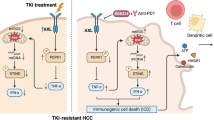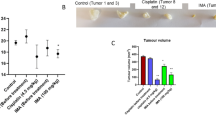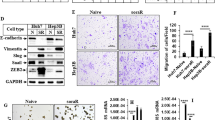Abstract
Aim:
To investigate the influences of methotrexate (MTX) on the anticancer actions and pharmacokinetics of 5-aminoimidazole-4-carboxamide riboside (AICA riboside) in human breast cancer and hepatocellular carcinoma.
Methods:
Human breast cancer cell line MCF-7 and human hepatocellular carcinoma cell line HepG2 were examined. The cell proliferation was assessed using a sulforhodamine B assay. Western blotting and radioactivity assays were used to analyze the phosphorylation of AMPK. The DNA synthesis was analyzed with BrdU incorporation. Nude mice bearing MCF-7 cell xenografts were used to for in vivo study. MTX (50 mg/kg, ip, per week) and AICA riboside (200 mg/kg, ip, every other day) were administered the animals for 2 weeks. The concentrations of AICA riboside and its active metabolite AICA ribotide in the plasma and tumors were measured with HPLC.
Results:
Synergistic cytotoxicity in vitro was observed with MTX (0.1, 0.5, and 1 μmol/L) combined with AICA riboside (0.25–1 mmol/L) in MCF-7 cells, and with MTX (0.5 and 1 μmol/L) combined with AICA riboside (0.5 and 1 mmol/L) in HepG2 cells. MTX (1 μmol/L) significantly enhanced the AICA riboside-induced AMPK activation and BrdU incorporation in both MCF-7 and HepG2 cells. Co-treatment with MTX and AICA riboside exerted more potent inhibition on the tumor growth in nude mice than either drug alone. After injection of AICA riboside (200 mg/kg, iv) in nude mice bearing MCF-7 xenografts, MTX (50 mg/kg, iv) significantly increased the concentrations of AICA riboside and its active metabolite AICA ribotide in tumors.
Conclusion:
MTX and AICA riboside exert synergistic anticancer action against MCF-7 and HepG2 cells in vitro and in vivo. MTX increases the concentration of AICA riboside and its active metabolite AICA ribotide in tumors in vivo.
Similar content being viewed by others
Log in or create a free account to read this content
Gain free access to this article, as well as selected content from this journal and more on nature.com
or
References
Sullivan JE, Carey F, Carling D, Beri RK . Characterisation of 5′-AMP-activated protein kinase in human liver using specific peptide substrates and the effects of 5′-AMP analogues on enzyme activity. Biochem Biophys Res Commun 1994; 200: 1551–6.
Carling D . The AMP-activated protein kinase cascade–a unifying system for energy control. Trends Biochem Sci 2004; 29: 18–24.
Corton JM, Gillespie JG, Hawley SA, Hardie DG . 5-Aminoimidazole-4-carboxamide ribonucleoside. A specific method for activating AMP-activated protein kinase in intact cells? Eur J Biochem 1995; 229: 558–65.
Hardie DG . The AMP-activated protein kinase pathway–new players upstream and downstream. J Cell Sci 2004; 117: 5479–87.
Hardie DG, Scott JW, Pan DA, Hudson ER . Management of cellular energy by the AMP-activated protein kinase system. FEBS Lett 2003; 546: 113–20.
Shaw RJ, Kosmatka M, Bardeesy N, Hurley RL, Witters LA, DePinho RA, et al. The tumor suppressor LKB1 kinase directly activates AMP-activated kinase and regulates apoptosis in response to energy stress. Proc Natl Acad Sci U S A 2004; 101: 3329–35.
Shackelford DB, Shaw RJ . The LKB1-AMPK pathway: metabolism and growth control in tumour suppression. Nat Rev Cancer 2009; 9: 563–75.
Jones RG, Plas DR, Kubek S, Buzzai M, Mu J, Xu Y, et al. AMP-activated protein kinase induces a p53-dependent metabolic checkpoint. Mol Cell 2005; 18: 283–93.
Campas C, Lopez JM, Santidrian AF, Barragan M, Bellosillo B, Colomer D, et al. Acadesine activates AMPK and induces apoptosis in B-cell chronic lymphocytic leukemia cells but not in T lymphocytes. Blood 2003; 101: 3674–80.
Robert G, Ben Sahra I, Puissant A, Colosetti P, Belhacene N, Gounon P, et al. Acadesine kills chronic myelogenous leukemia (CML) cells through PKC-dependent induction of autophagic cell death. PLoS One 2009; 4: e7889.
Saitoh M, Nagai K, Nakagawa K, Yamamura T, Yamamoto S, Nishizaki T . Adenosine induces apoptosis in the human gastric cancer cells via an intrinsic pathway relevant to activation of AMP-activated protein kinase. Biochem Pharmacol 2004; 67: 2005–11.
Guan TJ, Qin FJ, Du JH, Geng L, Zhang YY, Li M . AICAR inhibits proliferation and induced S-phase arrest, and promotes apoptosis in CaSki cells. Acta Pharmacol Sin 2007; 28: 1984–90.
Xiang X, Saha AK, Wen R, Ruderman NB, Luo Z . AMP-activated protein kinase activators can inhibit the growth of prostate cancer cells by multiple mechanisms. Biochem Biophys Res Commun 2004; 321: 161–7.
Imamura K, Ogura T, Kishimoto A, Kaminishi M, Esumi H . Cell cycle regulation via p53 phosphorylation by a 5′-AMP activated protein kinase activator, 5-aminoimidazole-4-carboxamide-1-beta-D-ribofuranoside, in a human hepatocellular carcinoma cell line. Biochem Biophys Res Commun 2001; 287: 562–7.
Swinnen JV, Beckers A, Brusselmans K, Organe S, Segers J, Timmermans L, et al. Mimicry of a cellular low energy status blocks tumor cell anabolism and suppresses the malignant phenotype. Cancer Res 2005; 65: 2441–8.
Rattan R, Giri S, Singh AK, Singh I . 5-Aminoimidazole-4-carboxamide-1-beta-D-ribofuranoside inhibits cancer cell proliferation in vitro and in vivo via AMP-activated protein kinase. J Biol Chem 2005; 280: 39582–93.
Acadesine: AICA riboside, ARA 100, arasine, GP 1 110. Drugs R D 2008; 9: 169–75.
Dixon R, Gourzis J, McDermott D, Fujitaki J, Dewland P, Gruber H . AICA-riboside: safety, tolerance, and pharmacokinetics of a novel adenosine-regulating agent. J Clin Pharmacol 1991; 31: 342–7.
Faltaos DW, Hulot JS, Urien S, Morel V, Kaloshi G, Fernandez C, et al. Population pharmacokinetic study of methotrexate in patients with lymphoid malignancy. Cancer Chemother Pharmacol 2006; 58: 626–33.
Longo-Sorbello GS, Bertino JR . Current understanding of methotrexate pharmacology and efficacy in acute leukemias. Use of newer antifolates in clinical trials. Haematologica 2001; 86: 121–7.
Fan LL, Sun GP, Wei W, Wang ZG, Ge L, Fu WZ, et al. Melatonin and doxorubicin synergistically induce cell apoptosis in human hepatoma cell lines. World J Gastroenterol 2010; 16: 1473–81.
Oshima T, Cao X, Grande F, Yamada R, Garofalo A, Louie S, et al. Combination effects of SC144 and cytotoxic anticancer agents. Anticancer Drugs 2009; 20: 312–20.
Beckers A, Organe S, Timmermans L, Vanderhoydonc F, Deboel L, Derua R, et al. Methotrexate enhances the antianabolic and antiproliferative effects of 5-aminoimidazole-4-carboxamide riboside. Mol Cancer Ther 2006; 5: 2211–7.
Vichai V, Kirtikara K . Sulforhodamine B colorimetric assay for cytotoxicity screening. Nat Protoc 2006; 1: 1112–6.
Zhou JR, Yu L, Mai Z, Blackburn GL . Combined inhibition of estrogen-dependent human breast carcinoma by soy and tea bioactive components in mice. Int J Cancer 2004; 108: 8–14.
Mai Z, Blackburn GL, Zhou JR . Soy phytochemicals synergistically enhance the preventive effect of tamoxifen on the growth of estrogen-dependent human breast carcinoma in mice. Carcinogenesis 2007; 28: 1217–23.
Chou TC, Talalay P . Quantitative analysis of dose-effect relationships: the combined effects of multiple drugs or enzyme inhibitors. Adv Enzyme Regul 1984; 22: 27–55.
Hardie DG, Salt IP, Davies SP . Analysis of the role of the AMP-activated protein kinase in the response to cellular stress. Methods Mol Biol 2000; 99: 63–74.
Cheng XL, Guo LP, Li ZQ, Li L, Zhou TY, Lu W . A HPLC method for simultaneous determination of 5-aminoimidazole-4-carboxamide riboside and its active metabolite 5-aminoimidazole-4-carboxamide ribotide in tumor-bearing nude mice plasma and its application to pharmacokinetics study. J Chromatogr B 2013; 915–916: 64–70.
Treon SP, Chabner BA . Concepts in use of high-dose methotrexate therapy. Clin Chem 1996; 42: 1322–9.
Romond EH, Perez EA, Bryant J, Suman VJ, Geyer CE Jr, Davidson NE, et al. Trastuzumab plus adjuvant chemotherapy for operable HER2-positive breast cancer. N Engl J Med 2005; 353: 1673–84.
Adams GP, Weiner LM . Monoclonal antibody therapy of cancer. Nat Biotechnol 2005; 23: 1147–57.
Mauritz R, Peters GJ, Kathmann I, Teshale H, Noordhuis P, Comijn EM, et al. Dynamics of antifolate transport via the reduced folate carrier and the membrane folate receptor in murine leukaemia cells in vitro and in vivo. Cancer Chemother Pharmacol 2008; 62: 937–48.
Ha T, Baggott JE . 5-Aminoimidazole-4-carboxamide ribotide (AICAR) and its metabolites: metabolic and cytotoxic effects and accumulation during methotrexate treatment. J Nutr Biochem 1994; 5: 522–8.
Hider SL, Bruce IN, Thomson W . The pharmacogenetics of methotrexate. Rheumatology (Oxford) 2007; 46: 1520–4.
Visentin M, Zhao R, Goldman ID . Augmentation of reduced folate carrier-mediated folate/antifolate transport through an antiport mechanism with 5-aminoimidazole-4-carboxamide riboside monophosphate. Mol Pharmacol 2012; 82: 209–16.
Acknowledgements
This work was supported by the Innovation Team of Ministry of Education, China (No BMU20110263E).
Author information
Authors and Affiliations
Corresponding authors
Rights and permissions
About this article
Cite this article
Cheng, Xl., Zhou, Ty., Li, B. et al. Methotrexate and 5-aminoimidazole-4-carboxamide riboside exert synergistic anticancer action against human breast cancer and hepatocellular carcinoma. Acta Pharmacol Sin 34, 951–959 (2013). https://doi.org/10.1038/aps.2013.16
Received:
Accepted:
Published:
Issue date:
DOI: https://doi.org/10.1038/aps.2013.16
Keywords
This article is cited by
-
Designing a novel drug–drug conjugate as a prodrug for breast cancer therapy: in silico insights
Molecular Diversity (2024)
-
Simultaneous Quantification of 5-Aminoimidazole-4-Carboxamide-1-β-d-ribofuranoside and Its Active Metabolite 5-Aminoimidazole-4-Carboxamide-1-β-d-ribofuranotide in Mice Plasma by LC–MS/MS
Chromatographia (2018)
-
Oxyphenbutazone promotes cytotoxicity in rats and Hep3B cellsvia suppression of PGE2 and deactivation of Wnt/β-catenin signaling pathway
Molecular and Cellular Biochemistry (2018)
-
Dexamethasone suppresses the growth of human non-small cell lung cancer via inducing estrogen sulfotransferase and inactivating estrogen
Acta Pharmacologica Sinica (2016)



